Assessment of Practical Methods to Predict Accumulated Rotations of Monopile-Supported Offshore Wind Turbines in Cohesionless Ground Profiles
Abstract
1. Introduction
- (1)
- The parameters that control the accumulation of tilt are the loading ratios: (Mmin/Mmax) and (Mmax/MR) where Mmin and Mmax are the minimum and maximum mudline bending moments corresponding to the appropriate load combination of the wind and the wave. On the other hand, MR is the Moment of Resistance of the pile i.e., ultimate static moment capacity of the pile considering soil failure around the pile (i.e., geotechnical failure) and strictly not the structural failure of the pile through buckling or yielding.
- (2)
- Jalbi et al. [6] assessed load ratios (Mmin/Mmax and Mmax/MR) for 15 operating wind turbines in European waters. The study showed that the load ratio varies widely ranging from extreme one-way loading to extreme two-way loading. There is clear mismatch of the actual load scenario and the parameters in the model tests.
- (3)
- Bundesamt für Seeschifffahrt und Hydrographie (BSH [7]) is the only code that provides guidance on the applicability of a typical OWT load time series arising from a typical storm or other loading condition such as the 35-h (hour) storm.
- (1)
- Present and outline the current available methods to calculate the accumulated rotation from scaled tests;
- (2)
- Present an overview of how to process a time series from the BSH [7] storm through classical rain flow counting and how these loads can be post-processed and used to calculate accumulated rotation;
- (3)
- Compare the outcome of the accumulated rotation from different sources and discuss the range of applicability of each method;
- (4)
- Compare the accumulated rotation during different periods of a storm;
- (5)
- Provide general guidance on future work in this area of research.
- (a)
- Rigid piles are short and bulky enough to undergo rigid body rotation in the soil under operational loads instead of bending like a clamped beam; the shear strength of the soil governs the design (i.e., the soil fails before the pile). Monopiles supporting offshore wind turbines are more likely to show rigid rather than flexible behaviour due to their large diameters. However, in very stiff soils and weak rock, flexible behaviour may be observed.
- (b)
- Flexible (or long) piles undergo deflection under operating loads and fail typically through plastic hinge formation.
- (c)
- One-way loading refers to when the ratio of the minimum to maximum load amplitude in each cycle is between 0 and 1, whilst two-way loading occurs when the ratio of the minimum to maximum load amplitude is between 0 and −1. A ratio of −1 is indicative of a full reversal in the load amplitude and sometimes termed as complete “two-way loading” in the literature.
2. Methods to Predict Accumulated Rotation
2.1. Monopiles in Sands
2.1.1. The Methods of Long & Vanneste and Lin & Liao
- FL is dependent on the cyclic load ratio and was recommended to be 1.0 for one-way loading (Mmin/Mmax = 0) and 0.2 for two-way loading (Mmin/Mmax = −1), FI is dependent on the installation method and ranges from 0.9 to 1.4, FD is dependent on the soil density and ranges from 0.8 to 1.1.
2.1.2. The Method of LeBlanc, Houlsby & Byrne
- θs is the static rotation, which can be obtained from a non-linear analysis using standard p–y curves, Tb is a function of the ratio of the maximum moment Mmax to the static resisting moment MR and the relative density of the sand, Tc is a function of Mmin/Mmax of each loading cycle and accounts for the load profile, θN is the rotation after N cycles of loading , α is an empirical factor that ranges between 0.3 to 0.31. Methods to calculate MR and other parameters are further elaborated in Appendix A.
- θsa is the static rotation due to load packet “a”, θsb is the static rotation due to load packet “b”, Na number of cycles of load packet “a”, Tba and Tca are the Tc and Tb factors in Equation (6) due to load packet “a”, Tbb and Tcb are the Tc and Tb factors in Equation (7) due to load packet “b”
2.1.3. Additional References in Sand
2.1.4. Modification of the LeBlanc, Houlsby & Byrne Method
- Accumulation over the initial rotation θ1 rather than the static rotation θs.
2.2. Monopiles in Clay
- puN is the ultimate resistance after N load cycles, D is the diameter of the monopile, ystatic is the static deformation of the monopile
2.3. Summary of Literature
3. Computation of Mudline Forces and Moments
- (1)
- Determine an “eccentricity” value to convert the mudline force to moment. This is calculated as the maximum value of the ratios of the maximum moment over the maximum shear force within each design event duration.
- (2)
The Time Series
- 10 min of extreme storm including a constrained wave.
- 170 min of extreme storm, which represents the peak 3 h of the storm, excluding the 10-min period that includes the constrained wave.
- 32 h of storm, which is the rest of the 35-h BSH storm, excluding the aforementioned 3-h peak storm.
- 25 years of fatigue loading.
4. Analysis Example
- A simplified method of assessing long-term tilt using a loading/unloading model based on cyclic p–y curves obtained from the API [2] and DNVGL [3] codes of practice. This is termed Method 1. The unloading stiffness is assumed to have the same slope as the loading stiffness, which is conservative considering the studies of Achmus et al. [26] (see, for example, Figure 7 for a schematic of the method).
- The LeBlanc et al. [11] method, which considers random two-way lateral loads in sands. This is termed Method 2.
- The modified LeBlanc et al. [11] method (the use of θ1) to investigate the sensitivity of the results to the parameters used. This is termed Method 3.
4.1. Comparison Between Methods 1, 2, and 3
4.2. Comparison to Other References
- Method 1 (direct implementation of cyclic p–y curves) does not capture the effect of the loading profile and is shown to result in a lower value of both the maximum and the accumulated rotation.
- Method 2 will result in higher rotations than Method 3 and this is because the accumulation in Method 2 occurs over the static values θs, whilst Method 3 considers the initial value θ1. Therefore, due to the noticeable difference between the two Methods, it is encouraged that further research is needed in addressing a practical method to calculate θ1.
- Method 2 and Method 3 are likely to show higher rotations than other sources in the literature such as Li et al. [10]. This is because these methods consider two-way loading to be more onerous for accumulated rotation than one-way loading.
- All methods considered the most “dominant loading profile”, where in reality the loads in opposing directions will counteract the movement and will possibly result in a lower rotation
4.3. Comparison Between Design Event Durations
- A 10-min simulation with an extreme wave; A 3-h peak storm; A full 35-h BSH storm; A full 35-h BSH storm and 25 Years of fatigue loading.
5. General Conclusions and Recommendations
- The loading profile (Mmin/Mmax) plays a detrimental role in the result of the accumulated rotation. Different tests from different sources of literature debate the effect of the loading profile on the long term-tilt. Without other supporting data, it is recommended to follow the methods that would provide conservative estimates in terms of loading direction until further developments are available in the near future.
- The flexibility of the pile also has an important effect on the response of the pile. Results obtained from formulations based on flexible piles resulted in a much lower accumulated rotation than tests based on rigid piles.
- When selecting a design event duration, it can be observed that the 10-min time series with extreme wave predicts over 80% of the accumulated rotation. This is considered acceptable for early stages of the design. It may be necessary to consider at least the 3-h peak storm in detailed design to account for the majority, i.e. >96%, of the accumulated rotation. It is recommended that, if the turbine is sensitive to SLS displacements, then a small number of studies are carried out using the full 35-h BSH storm and/or the fatigue loading.
- If fatigue loading is to be considered in the assessment, the regression model is recommended as the maximum eccentricity method is believed to over-predict the accumulated rotations.
- Accumulating over θ1 resulted in a significant reduction when compared with accumulating over θs. However, this would need further validation through testing and advanced analysis.
- In general, there is more research directed to sands than clays. With the emergence of offshore markets in other areas around the world, it is recommended that some additional insight must be available on the performance of monopiles in clay. There are also no insights on the performance in two-layered or multi-layered ground profiles.
- There has not been extended work on understanding how the order of loads affects the accumulated rotation of the monopile. The Neq method rearranges the load packets from largest to smallest, which is acceptable to storm type loading. However, it is recommended that a mixture of loads are applied in scaled tests to gain a further understanding of the response.
- The load reversal of identical but opposite (in direction) loads has been touched upon in the literature. However, as previously discussed, it is current practice to analyse each loading profile separately and it is not clear how to incorporate the “net” effect of the positive and negative loads.
- It is evident that using the static rotation for accumulated rotation calculations results in higher values than other methods. It is therefore recommended that guidance should be available on different methods to predict the value of θ1 and how to include it in design calculations.
- Loads applied in scaled tests available in the literature range from extremely two-way to extremely one-way. Analysis of the loads shows that the highest load packets of a storm are partially two-way. In addition, other parameters such as Mmax/MR should be more reflective of the actual loads applied in an offshore wind farm.
- Current tests are either on very rigid or very flexible piles. Typical installations in stiff grounds will result in an intermediate response of the monopile. Further studies on the effect of pile flexibility are desirable.
- Further tests in other relative densities are required to confirm the methodology in other sandy ground profiles.
Author Contributions
Funding
Conflicts of Interest
Appendix A
Appendix A.1. Calculation and Derivation of Parameters for LeBlanc et al.
Appendix A.2. Calculation of Tb and Tc
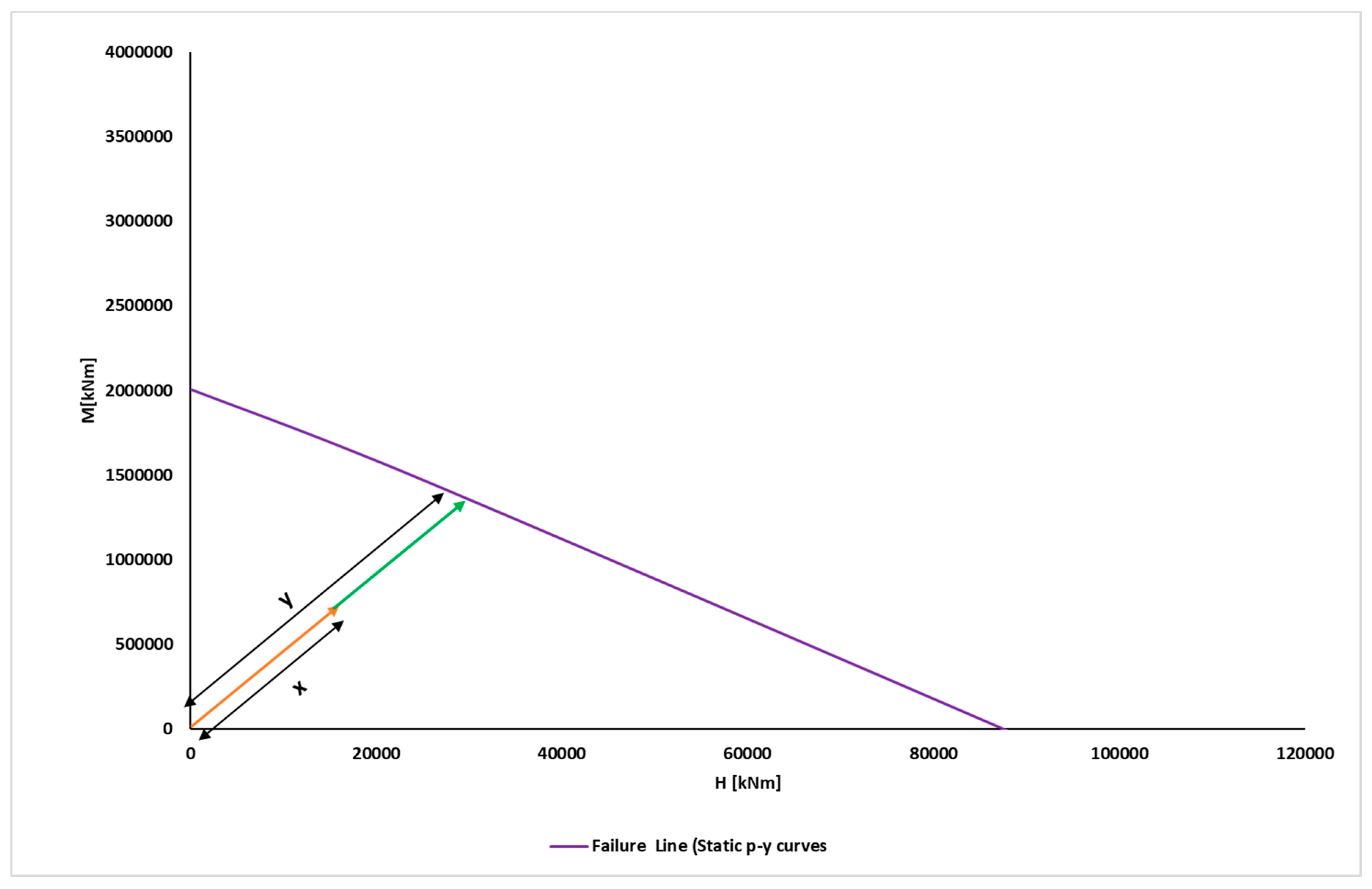
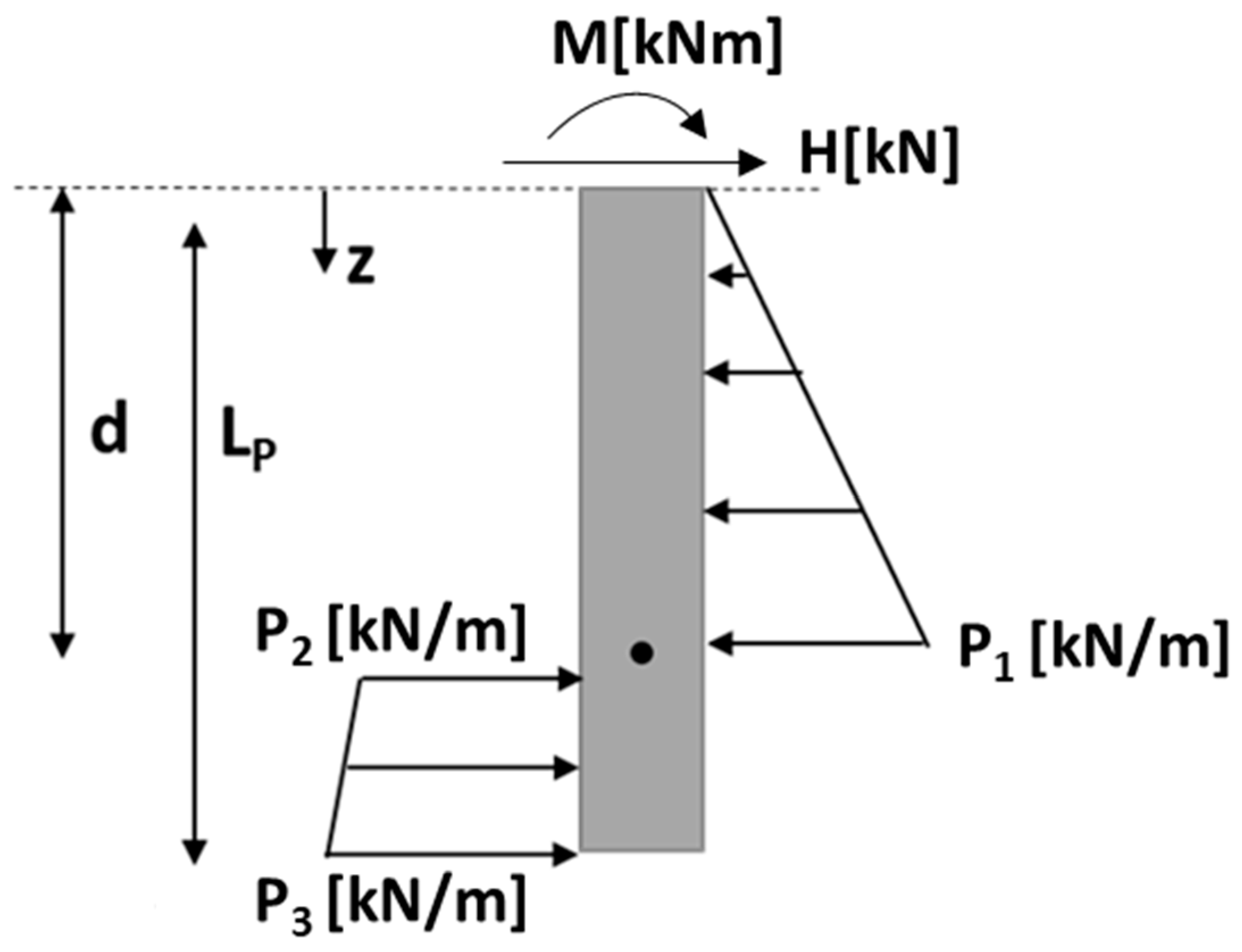
- Lp is the embedment depth of the monopile.
- d is the point of rotation at a certain load level.
- P1 and P2 are the soil failure pressures at the point of rotation “d”. They are equal in magnitude and opposite in direction.
- P3 is the soil failure pressure at the pile toe. A B–y spring can also be added in this location if needed.
- H is the external applied shear at the mudline and M is the external applied overturning moment.
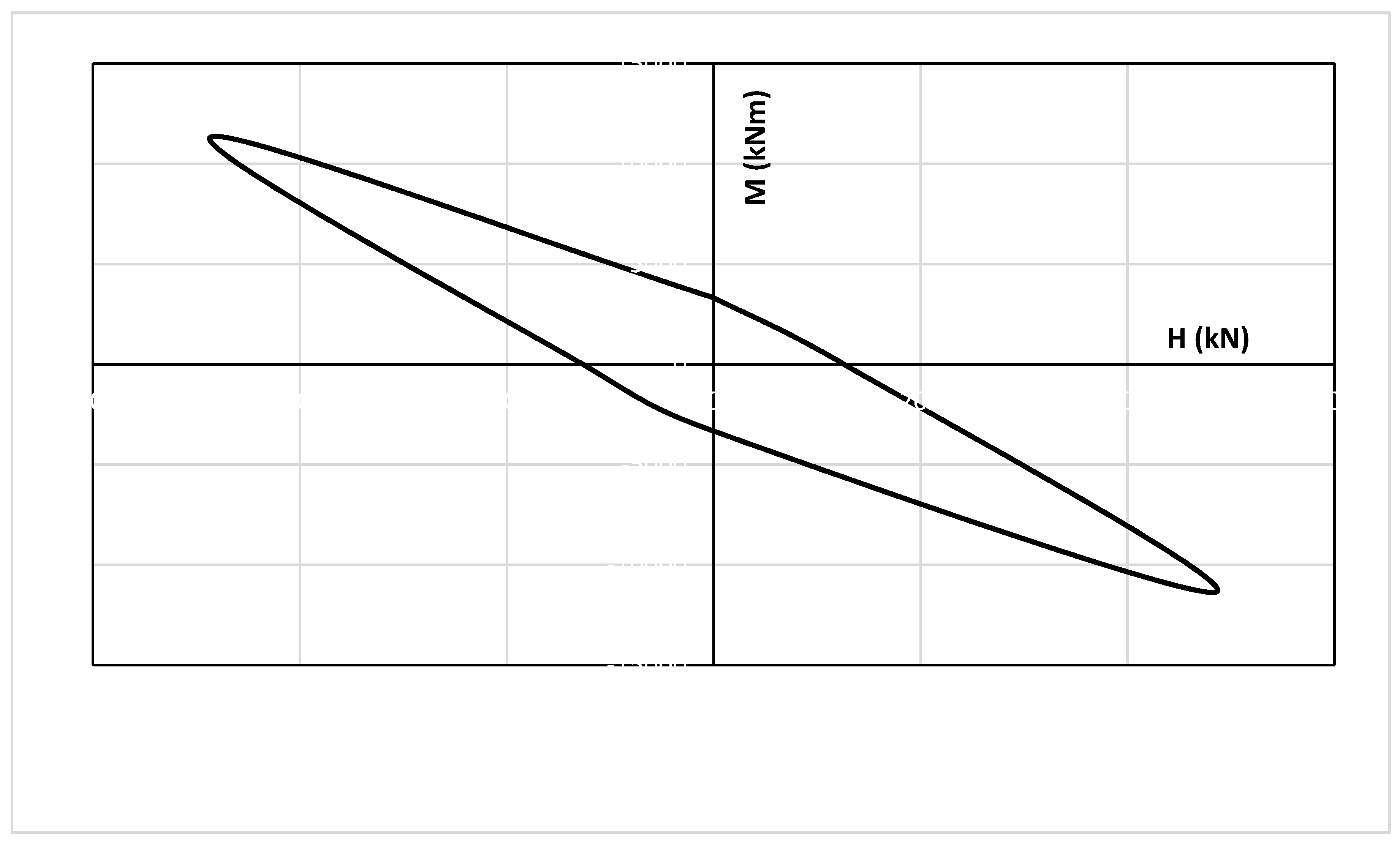
References
- Harrabin Climate Change: Offshore Wind Expands at Record Low Price. BBC. 2019. Available online: https://www.bbc.co.uk/news/uk-49769259 (accessed on 30 October 2019).
- American Petroleum Institute (API). API RP 2GEO Geotechnical and Foundation Design Considerations: ISO 19901-4:2003 (Modified), Petroleum and Natural Gas Industries–Specific Requirements for Offshore Structures, Part 4, 1st ed.; American Petroleum Institute: Washington, DC, USA, 2011; p. 120. [Google Scholar]
- DNV GL. DNVGL-RP-C212 Offshore Soil Mechanics and Geotechnical Engineering; DNV GL AS: Oslo, Norway, 2017. [Google Scholar]
- Kallehave, D.; LeBlanc, C.; Liingaard, M. Modification of the API py formulation of initial stiffness of sand. In Proceedings of the Offshore Site Investigation and Geotechnics: Integrated Technologies—Present and Future, London, UK, 12–14 September 2012. [Google Scholar]
- Thieken, K.; Achmus, M.; Terceros, M.; Lemke, K. Evaluation of py Approaches for Large-Diameter Piles in Layered Sand. Int. J. Offshore Polar Eng. 2018, 28, 318–327. [Google Scholar] [CrossRef]
- Jalbi, S.; Arany, L.; Salem, A.; Cui, L.; Bhattacharya, S. A method to predict the cyclic loading profiles (one-way or two-way) for monopile supported offshore wind turbines. Mar. Struct. 2019, 63, 65–83. [Google Scholar] [CrossRef]
- Bundesamt Für Seeschifffahrt Und Hydrographie (BSH). Standard Design: Minimum requirements concerning the constructive design of offshore structures within the Exclusive Economic Zone; BSH No.: 7005; BSH: Hamburg, Gremany; Rostock, Gremany, 2015. [Google Scholar]
- Long, J.; Vanneste, G. Effects of cyclic lateral loads on piles in sand. J. Geotech. Eng. 1994, 120, 225–244. [Google Scholar] [CrossRef]
- Lin, S.; Liao, J. Permanent strains of piles in sand due to cyclic lateral loads. J. Geotech. Geoenviron. Eng. 1999, 125, 798–802. [Google Scholar] [CrossRef]
- Li, W.; Igoe, D.; Gavin, K. Field tests to investigate the cyclic response of monopiles in sand. Geotech. Eng. 2015, 168, 407–421. [Google Scholar] [CrossRef]
- LeBlanc, C.; Byrne, B.W.; Houlsby, G.T. Response of stiff piles to random two-way lateral loading. Geotechnique 2010, 60, 715–721. [Google Scholar] [CrossRef]
- LeBlanc, C.; Houlsby, G.; Byrne, B. Response of stiff piles in sand to long-term cyclic lateral loading. Géotechnique 2010, 60, 79–90. [Google Scholar] [CrossRef]
- Stewart, H. Permanent strains from cyclic variable amplitude loadings. J. Geotech. Eng. 1986, 112, 646–660. [Google Scholar] [CrossRef]
- Cathie Associates. OPILE–Single Pile Axial and Lateral Analysis: Instruction Manual; Cathie Associates: Diegem, Belgium, 2019. [Google Scholar]
- Rudolph, C.; Bienen, B.; Grabe, J. Effects of variation of loading direction on the displacement accumulation of large piles under cyclic lateral loads in sand. Can. Geotech. J. 2014, 51, 1196–1206. [Google Scholar] [CrossRef]
- Nanda, S.; Arthur, I.; Sivakumar, V.; Donohue, S.; Bradshaw, A.; Keltai, R.; Gavin, K.; Mackinnon, P.; Rankin, B.; Glynn, D. Monopiles subjected to uni- and multi-lateral cyclic loading. Geotech. Eng. 2017, 170, 246–258. [Google Scholar] [CrossRef]
- Richards, I.A.; Byrne, B.W.; Houlsby, G.T. Monopile rotation under complex cyclic lateral loading in sand. Géotechnique 2019, 1–15. [Google Scholar] [CrossRef]
- Truong, P.; Lehane, B.M.; Zania, V.; Klinkvort, R.T. Empirical approach based on centrifuge testing for cyclic deformations of laterally loaded piles in sand. Géotechnique 2018, 69, 133–145. [Google Scholar] [CrossRef]
- Abiker, J.; Achmus, M. Development and validation of a numerically derived scheme to assess the cyclic performance of offshore monopile foundations. In Numerical Methods in Geotechnical Engineering IX; CRC Press: Boca Raton, FL, USA, 2008; Volume 2, pp. 1541–1547. [Google Scholar]
- Carswell, W.; Arwade, S.R.; DeGroot, D.J.; Myers, A.T. Natural frequency degradation and permanent accumulated rotation for offshore wind turbine monopiles in clay. Renew. Energy 2016, 97, 319–330. [Google Scholar] [CrossRef]
- Zhang, Y.; Andersen, K.H.; Jeanjean, P.; Mirdamadi, A.; Gundersen, A.S.; Jostad, H.P. A framework for cyclic p-y curves in clay and application to pile design in GoM. In Proceedings of the OSIG SUT Conference, London, UK, 12–14 September 2017. [Google Scholar]
- Lombardi, D.; Bhattacharya, S.; Wood, D.M. Dynamic soil-structure interaction of monopile supported wind turbines in cohesive soils. Soil Dyn. Earthq. Eng. 2013, 49, 165–180. [Google Scholar] [CrossRef]
- Matsuishi, M.; Endo, T. Fatigue of metals subjected to varying stress. Jpn. Soc. Mech. Eng. 1968, 68, 37–40. [Google Scholar]
- Rychlik, I. A new definition of the rainflow cycle counting method. Int. J. Fatigue 1987, 9, 119–121. [Google Scholar] [CrossRef]
- Wang, S.; Larsen, T.J. Permanent accumulated rotation of an offshore monopile wind turbine in sand during a storm. Ocean Eng. 2019, 188, 106340. [Google Scholar] [CrossRef]
- Achmus, M.; Thieken, K.; Saathoff, J.E.; Terceros, M.; Albiker, J. Un-and reloading stiffness of monopile foundations in sand. Appl. Ocean Res. 2019, 84, 62–73. [Google Scholar] [CrossRef]
- Bolton, M.D. Strength and dilatancy of sands. Geotechnique 1986, 36, 65–78. [Google Scholar] [CrossRef]
- Poulos, H.G.; Davis, E.H. Pile Foundation Analysis and Design; Wiley: Sussex, UK, 1980. [Google Scholar]
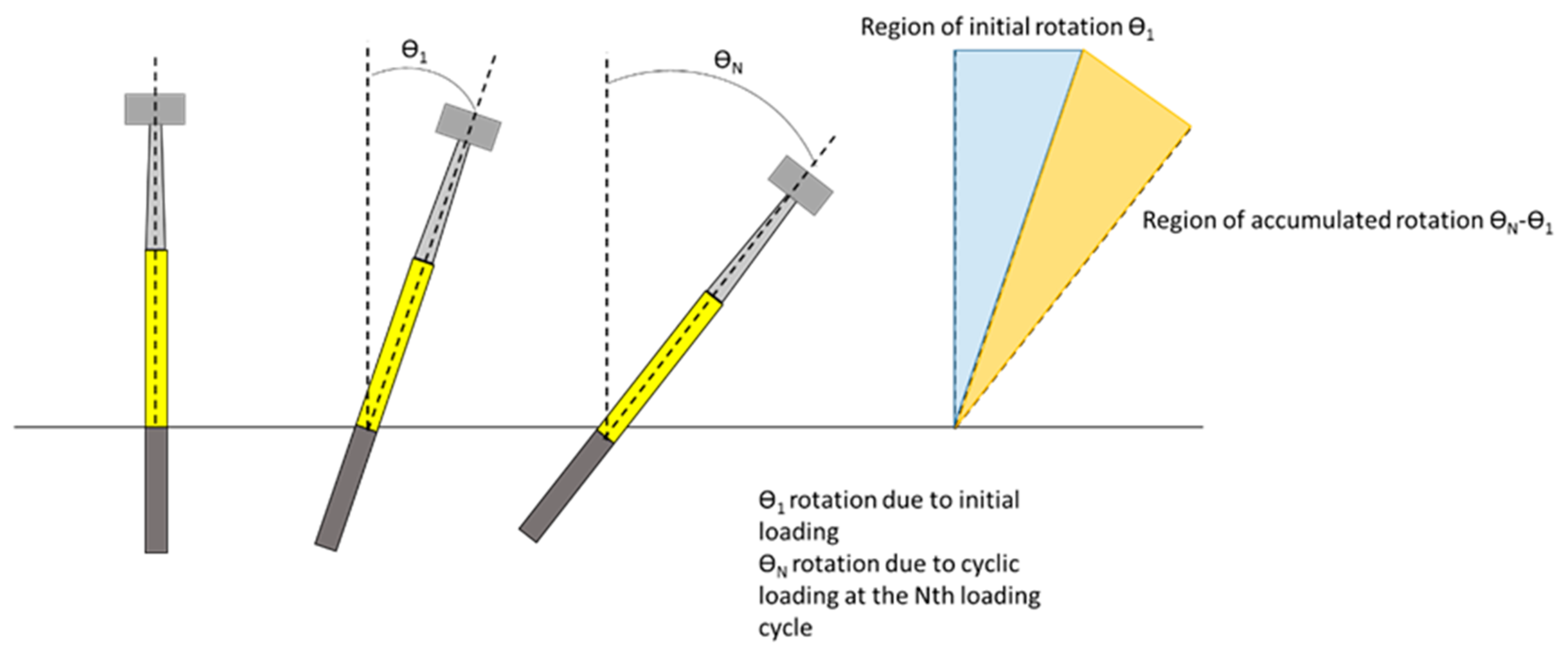


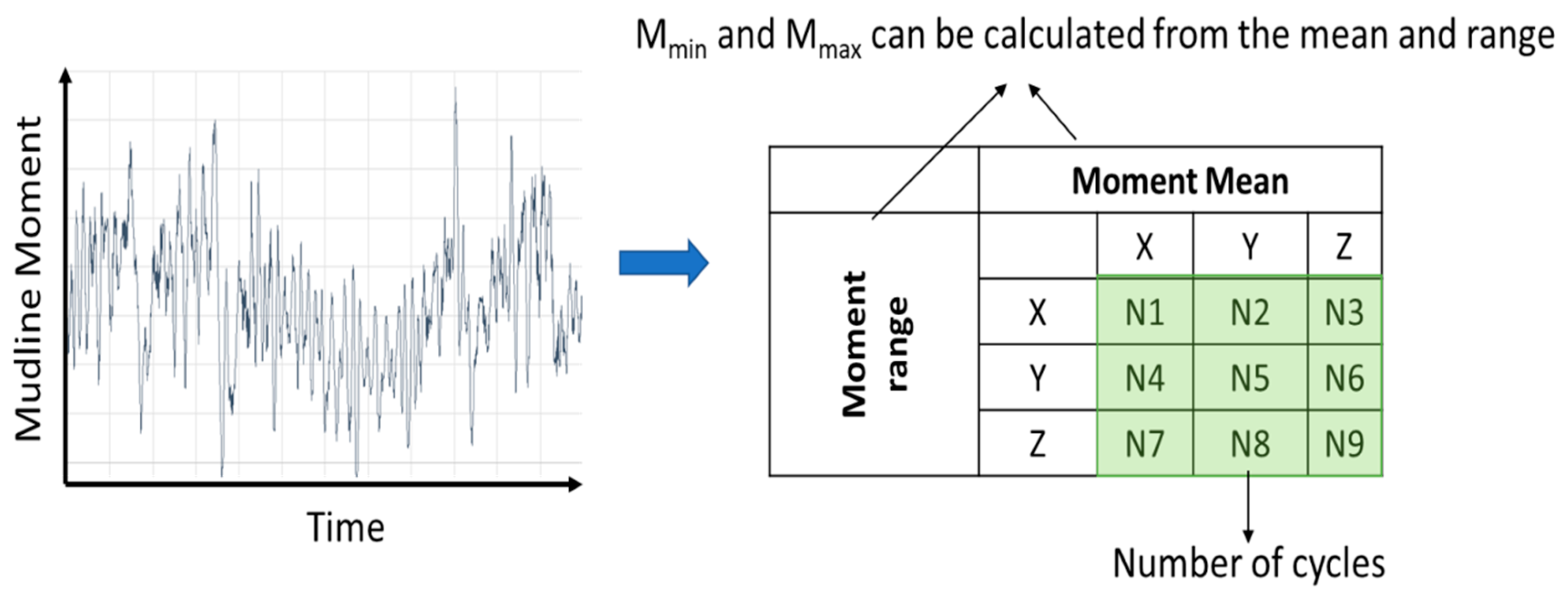
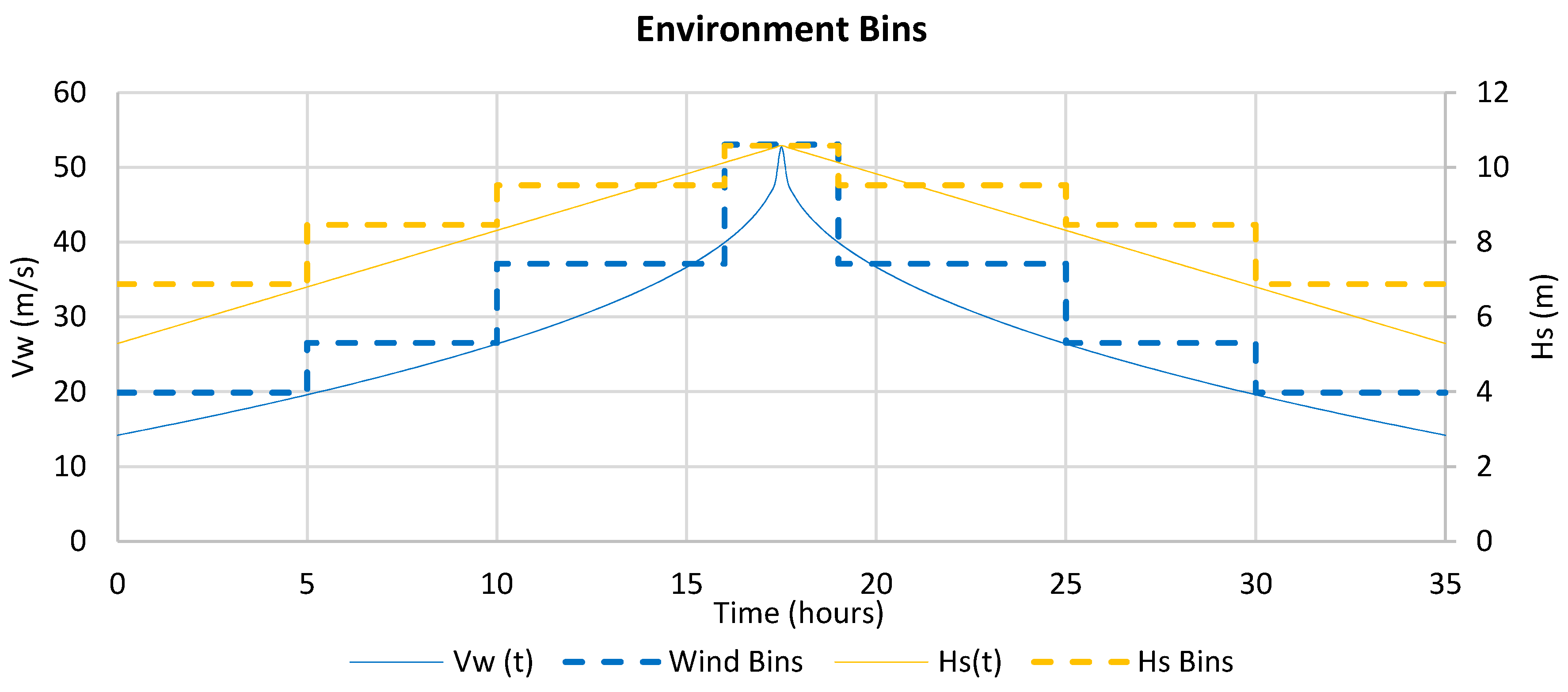

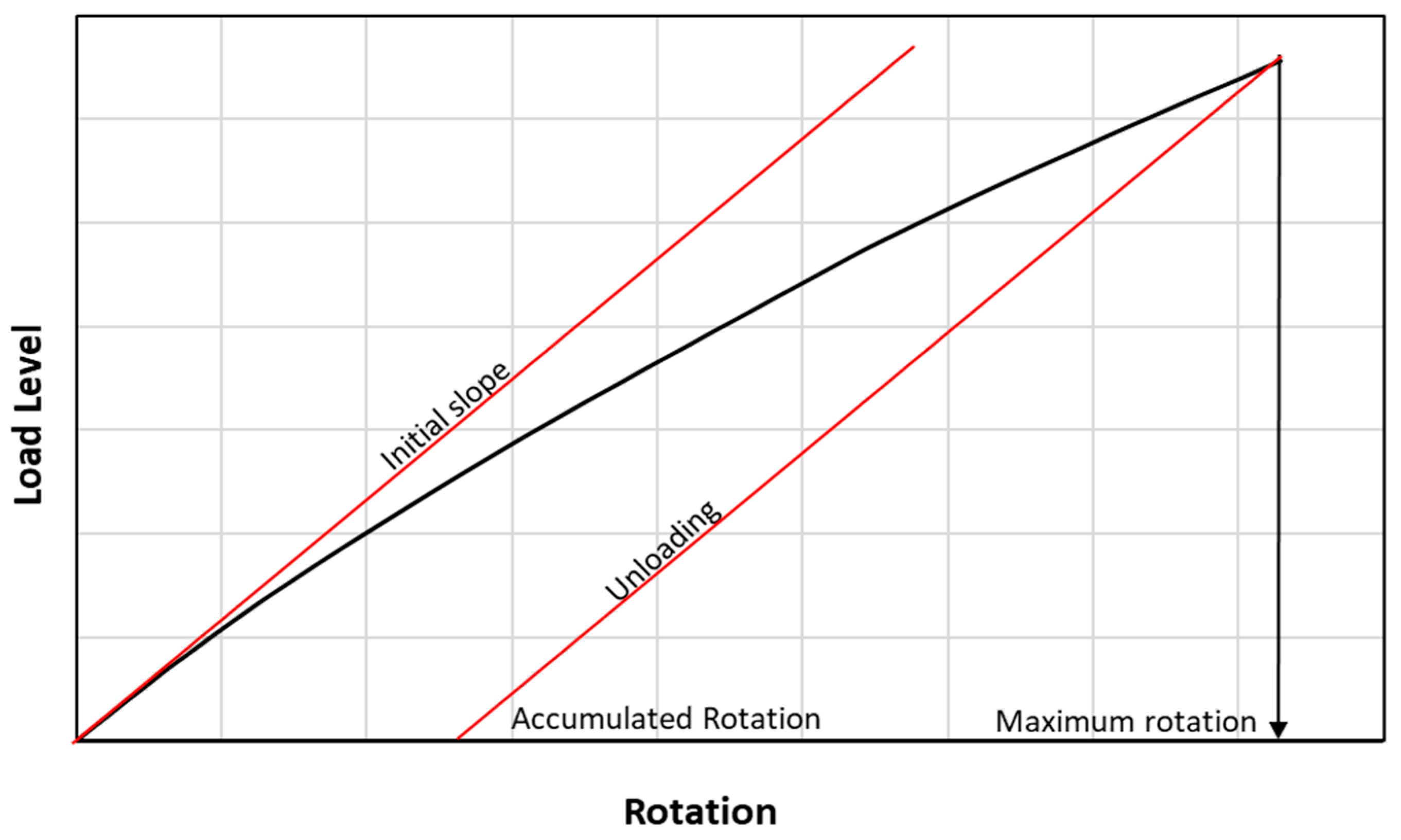

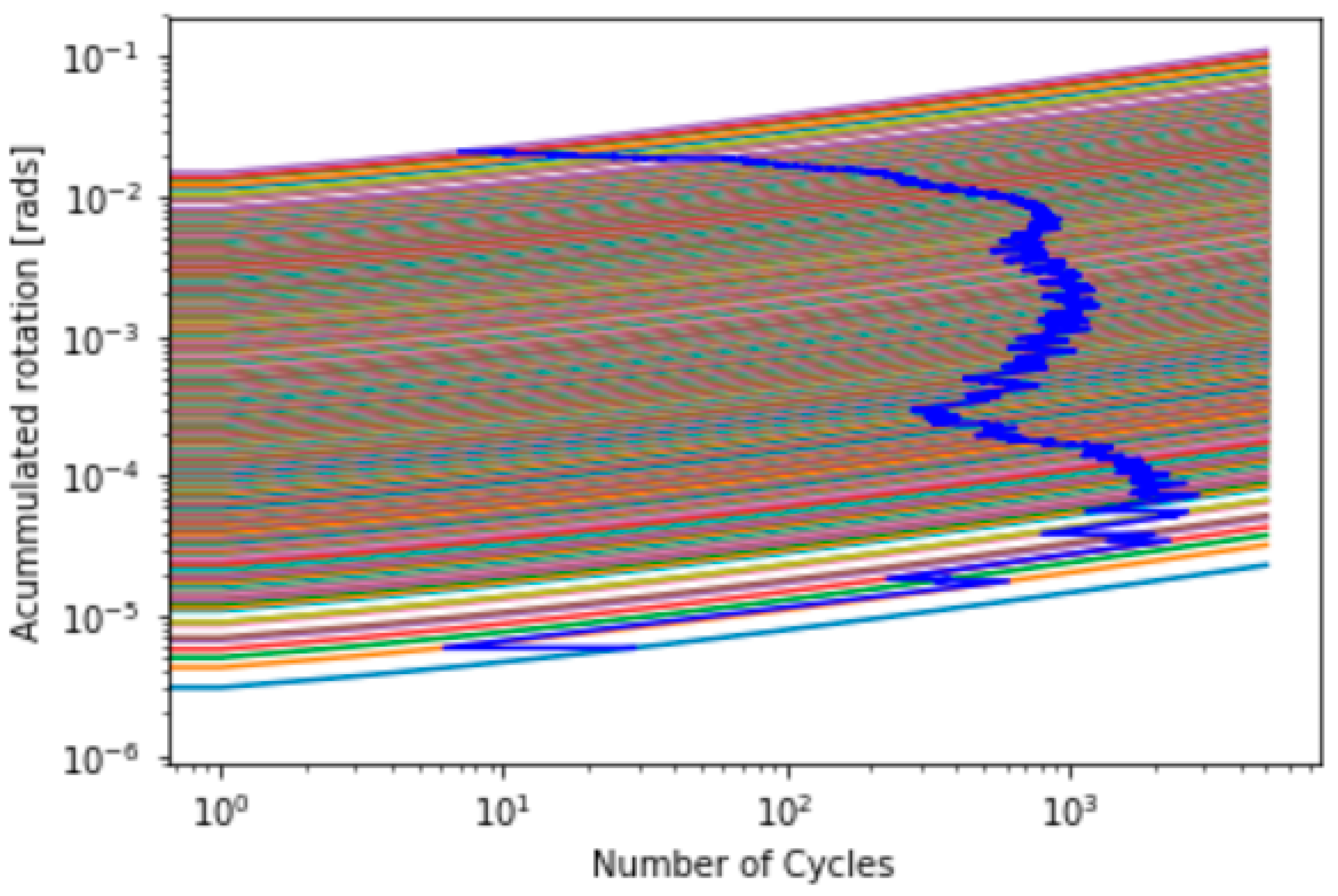
| Reference | Method | Effect of Loading Profile Mmin/Mmax | Applicability |
|---|---|---|---|
| Long & Vanneste [8] | Full scale tests in sands | One-way loading results in a higher degradation parameter to the p–y formulation | Tests were performed on flexible piles for less than 100 loading cycles, which is less than what is experienced by an offshore WTG |
| Lin & Liao [9] | Full scale tests in sands | One-way loading results in a higher degradation parameter, which leads to a higher pile head deformation | Tests were mostly on flexible piles and loading for less than 100 loading cycles, which is less than what is experienced by an offshore WTG |
| LeBlanc et al. [11] | Laboratory scaled tests for rigid monopiles in sand | Partial two-way loading results in a much higher degradation and leads to more rotation accumulation than one-way loads | Tests were performed on a rigid pile in sands for up to 65,000 loading cycles, which is more representative of an offshore WTG environment |
| Li et al. [10] | Field tests on small scale to intermediate rigid piles in sand | Only performed tests for one-way load and did not assess the damage for two-way loads | Tests were performed on piles in sands for 5000 cycles |
| Albiker & Achmus [19] | Presented a model for stiffness degradation in a finite element model | Applicable to one-way loading in drained conditions | Method compared to and validated against Li et al. [10] |
| Richards et al. [17] | Laboratory scaled tests for rigid monopiles in sand | Partial two-way loading results in a much higher degradation and leads to more rotation accumulation than one-way loads, however with a smaller factor than LeBlanc et al. [11] | Tests were performed on a rigid pile in sands for up to 10,000 loading cycles. The response of the monopile to multi-directional storm loading was also studied |
| Truong et al. [18] | Centrifuge testing of monopiles in sand | Highest accumulated rotations were observed in shorter piles with Mmin/Mmax > −0.5 | Tests were performed on multiple aspect ratio monopiles in sand for up to 1500 cycles |
| Carswell et al. [20] | Provided a p–y degradation method based on laboratory tests in clay | Only performed tests for one-way cyclic loads | Tests were performed for up to 300 loading cycles for flexible piles in clay with a close match to API [2] cyclic p–y curves |
| Zhang et al. [21] | Provided a p–y degradation method for piles in clay based on element tests | Dependent on the DSS and Cyclic Triaxial Tests | - |
| Unloading/reloading from API [2]/ DNVGL [3] cyclic p–y curves | Use an unloading stiffness similar to the initial loading stiffness to obtain the final deformation of the pile | Load directionality not considered | Simplified method used for an initial assessment |
| Parameter | Method 1 | Method 2 | Method 3 |
|---|---|---|---|
| Maximum static rotation θs [°] | - | 0.52 | 0.52 |
| Maximum rotation experienced by the monopile θN [°] | 0.88 | 1.59 | 1.32 |
| Maximum restored rotation after last load packet θN [°] | 0.46 | - | 1.27 |
| Neq [-] | - | 18.22 | 8.02 |
| Mmin/Mmax of highest load packet | −0.69 | ||
| Parameter | Method 1 | Method 2 | Method 3 |
|---|---|---|---|
| Maximum static rotation θs [°] | - | 0.52 | 0.52 |
| Maximum rotation experienced by the monopile θN [°] | 0.88 | 1.25 | 0.98 |
| Maximum restored rotation after last load packet θN [°] | 0.46 | - | 0.92 |
| Neq [-] | - | 6.7 | 2.15 |
| Mmin/Mmax of highest load packet | −0.69 | ||
| Parameter | 10-Min with Extreme Wave | 3-h | Full BSH [7] Storm | Full BSH Storm & 25-Year Fatigue |
|---|---|---|---|---|
| Maximum static rotation, θs [°] | 0.52 | 0.52 | 0.52 | 0.52 |
| Maximum rotation experienced by the monopile, θN [°] | 0.88 | 1.1 | 1.32 | 4.2 |
| Maximum restored rotation after last load packet, θN [°] | 0.86 | 1.03 | 1.27 | 4.1 |
| Neq [-] | 1.78 | 4.71 | 8.02 | 862 |
| Parameter | 10-Min with Extreme Wave | 3-h | Full BSH Storm | Full BSH Storm & 25-Year Fatigue |
|---|---|---|---|---|
| Maximum static rotation θs [°] | 0.52 | 0.52 | 0.52 | 0.52 |
| Maximum rotation experienced by the monopile θN [°] | 0.91 | 0.95 | 0.98 | 1.05 |
| Maximum restored rotation after last load packet θN [°] | 0.85 | 0.91 | 0.92 | 1.01 |
| Neq [-] | 1.43 | 1.83 | 2.15 | 3.13 |
© 2020 by the authors. Licensee MDPI, Basel, Switzerland. This article is an open access article distributed under the terms and conditions of the Creative Commons Attribution (CC BY) license (http://creativecommons.org/licenses/by/4.0/).
Share and Cite
Jalbi, S.; Hilton, J.; Jacques, L. Assessment of Practical Methods to Predict Accumulated Rotations of Monopile-Supported Offshore Wind Turbines in Cohesionless Ground Profiles. Energies 2020, 13, 3915. https://doi.org/10.3390/en13153915
Jalbi S, Hilton J, Jacques L. Assessment of Practical Methods to Predict Accumulated Rotations of Monopile-Supported Offshore Wind Turbines in Cohesionless Ground Profiles. Energies. 2020; 13(15):3915. https://doi.org/10.3390/en13153915
Chicago/Turabian StyleJalbi, Saleh, Joseph Hilton, and Luke Jacques. 2020. "Assessment of Practical Methods to Predict Accumulated Rotations of Monopile-Supported Offshore Wind Turbines in Cohesionless Ground Profiles" Energies 13, no. 15: 3915. https://doi.org/10.3390/en13153915
APA StyleJalbi, S., Hilton, J., & Jacques, L. (2020). Assessment of Practical Methods to Predict Accumulated Rotations of Monopile-Supported Offshore Wind Turbines in Cohesionless Ground Profiles. Energies, 13(15), 3915. https://doi.org/10.3390/en13153915




